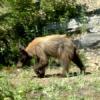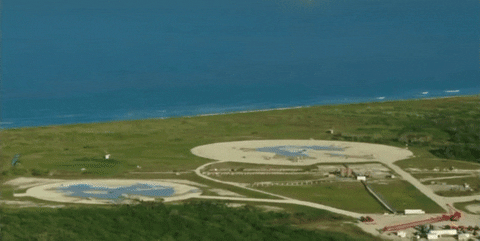Leaderboard
Popular Content
Showing content with the highest reputation on 04/12/2019 in all areas
-
I cannot see us colonizing Mars within a 100 years. Mars might be humanities lifeboat in about 4 billion years when our sun goes red giant and swallows up the Earth. Unless we discover mineral resources that make the trip pay I cannot see colonization . We will probably land geologists etc and do some exploration. It will end like the moon. Nothing much to find. The only thing from that which would light the fire of further exploration would be fossils etc. They may very will be there. My son has been on the JPL team that landed three rovers on the planet and is working on the 2020 Rover. I have said that if he wants to light the fire of exploration he just needs to put a chicken bone in the rover that bounces out onto the surface when they land. By the time they figure out it was a hoax they would have committed billions in money for exploration.1 point
-
Yes. We also have plate tectonics. Warm up your Google search finger and find another planet with plate tectonics. Our plate movement is critical for our carbon-oxygen-hydrogen cycle. Keeps the crust saturated with water too. Geological chaos has put minerals and liquid petroleum items in relatively close proximity to the surface so our extraction techniques are not complicated. There is water on Mars. Besides the polar caps, researchers found a lake close the southern polar cap. Don't drink the water. https://science.sciencemag.org/content/361/6401/490 The Mars Polar Lander was programed to land in the area close to the southern ice cap. It crashed, Dec. 1999. Over flight photographic missions have not found wreckage. I have not read any articles about generating oxygen based upon contemporary methods like electrolysis. Landers and rovers have done testing on soils and it looks like really boring dirt. No mention of 'valuable' minerals worth extraction. Mars has more inclination than Earth. Solar arrays have seasonal/dust storm limitations. Landers and rovers with solar panels have slow/sleep modes. The rovers with RTG's ( Radioactive Thermal Generators ) are on the go 24/7 for years. Well, RTG's blow it for the green squads. And what about the Schumann frequencies? Humans do poorly when not in close proximity to the Earth's natural frequencies. So pie in the sky plans are to make an artificial magnetic field and add the extra optional Schumann frequency generator. I will not hold my breath. Robots are really good in space and on other planets. Send them. Be safe out there. Remember, most accidents happen within 249 million miles of home. This thread has wandered quite a bit......the typical amount.1 point
-
The problem with Terriforming Mars is the reason Mars does not have much atmosphere in the first place. It is because the iron core cooled off and the magnetic field collapsed. That magnetic field, like on earth, protects the atmosphere from being stripped away by the solar wind. When the Earths core cools off and is no longer molten the same thing will happen here but a lot quicker since we are closer to the sun. So you need to heat the core to molten or build some sort of giant planet wide magnetic field to have anything that lasts. Earths moon helps in that is it large for a moon and fairly close. The tidal forces do some heating to the earths core.1 point
-
What do you think we have done for 10’s of thousands of years? Sheep, goats, cattle, horses and dogs? Lettuce, potatos, wheat, rice, apples, oranges? Farm fields where there was once trees? Dams and irrigation where there was once desert. The human race may very well be arrogant? But we also get stuff done. Terraforming Mars to support life for the benefit of humans is just a continuation of it. A trip to the supermarket proves it so. We are going to fail many times in space. Just as we inched along with trial and error on Earth. But progress will be made.1 point
-
I would likely be suicidal as you went nuts. I simply couldn't imagine a more depressing environment. At least at the bottom of the sea you'd see other life now and then (although you wouldn't see the sun). I was talking with a friend about another friend who retired with us and got a job at Point Thompson near Prudhoe Bay. It's only a 6-9 week gig in the winter, but that would be 6-9 weeks of -40 degree temps or colder, and no sun for even a moment the entire time. You'd may as well be on the dark side of the moon. $3500 per week with all expenses paid ain't enough money.........1 point
-
1 point
-
I grew up a half mile from the Platte river, God's gift to the westward pioneers. A more natural travel path I couldn't imagine. Across the Platte valley, as it broadly flows from the west, one occasionally comes across small patches of iris flowers. These mark the gravesites of many of the departed pioneers. I always offer up a small prayer when I encounter them. They were planted alongside the graves at the time of their internment, and naturally reproduce annually.1 point
-
From Wiki: The O'Neill cylinder (also called an O'Neill colony) is a space settlement design proposed by American physicist Gerard K. O'Neill in his 1976 book The High Frontier: Human Colonies in Space.[1] O'Neill proposed the colonization of space for the 21st century, using materials extracted from the Moon and later from asteroids.[2] An O'Neill cylinder would consist of two counter-rotating cylinders. The cylinders would rotate in opposite directions in order to cancel out any gyroscopic effects that would otherwise make it difficult to keep them aimed toward the Sun. Each would be 5 miles (8.0 km) in diameter and 20 miles (32 km) long, connected at each end by a rod via a bearing system. They would rotate so as to provide artificial gravity via centrifugal force on their inner surfaces.[1] While teaching undergraduate physics at Princeton University, O'Neill set his students the task of designing large structures in outer space, with the intent of showing that living in space could be desirable. Several of the designs were able to provide volumes large enough to be suitable for human habitation. This cooperative result inspired the idea of the cylinder, and was first published by O'Neill in a September 1974 article of Physics Today.[3] O'Neill's project was not completely without precedent. In 1954, the German scientist Hermann Oberth described the use of gigantic habitable cylinders for space travel in his book Menschen im Weltraum – Neue Projekte für Raketen- und Raumfahrt ("People in space – New projects for rockets and space travel"). Islands[edit] O'Neill created[when?] three reference designs, nicknamed "islands": Island One is a rotating sphere measuring one mile (1.6 km) in circumference (1,681 feet (512 m) in diameter), with people living on the equatorial region (see Bernal sphere). A later NASA/Ames study at Stanford University developed an alternative version of Island One: the Stanford torus, a toroidal shape 1,600 feet (490 m) in diameter.[4] Island Two is also spherical in design, and is 5,200 feet (1,600 m) in diameter.[citation needed] The Island Three design, better known as the O'Neill cylinder, consists of two counter-rotating cylinders, each five miles (8.0 km) in diameter, and capable of scaling up to twenty miles (32 km) long.[5] Each cylinder has six equal-area stripes that run the length of the cylinder; three are transparent windows, three are habitable "land" surfaces. Furthermore, an outer agricultural ring, twenty miles (32 km) in diameter, rotates at a different speed to support farming. The habitat's industrial manufacturing block is located in the middle, to allow for minimized gravity for some manufacturing processes. To save the immense cost of rocketing the materials from Earth, these habitats would be built with materials launched into space from the Moon with a magnetic mass driver.[1] Design[edit] Artificial gravity[edit] A NASA lunar base concept with a mass driver (the long structure that extends toward the horizon that is a part of the plan to build O'Neill Cylinders) The cylinders rotate to provide artificial gravity on their inner surface. At the radius described by O'Neill, the habitats would have to rotate about twenty-eight times an hour to simulate a standard Earth gravity; an angular velocity of 2.8 degrees per second. Research on human factors in rotating reference frames[6][7][8][9][10] indicate that, at such low rotation speeds, few people would experience motion sickness due to coriolis forces acting on the inner ear. People would, however, be able to detect spinward and antispinward directions by turning their heads, and any dropped items would appear to be deflected by a few centimetres.[9] The central axis of the habitat would be a zero-gravity region, and it was envisaged that recreational facilities could be located there. Atmosphere and radiation[edit] The habitat was planned to have oxygen at partial pressures roughly similar to terrestrial air, 20% of the Earth's sea-level air pressure. Nitrogen would also be included to add a further 30% of the Earth's pressure. This half-pressure atmosphere would save gas and reduce the needed strength and thickness of the habitat walls.[1][4] Artist's depiction of the interior of an O'Neill cylinder, illuminated by reflected sunlight At this scale, the air within the cylinder and the shell of the cylinder provide adequate shielding against cosmic rays.[1] The internal volume of an O'Neill cylinder is great enough to support its own small weather systems, which may be manipulated by altering the internal atmospheric composition or the amount of reflected sunlight.[5] Sunlight[edit] Large mirrors are hinged at the back of each stripe of window. The unhinged edge of the windows points toward the Sun. The purpose of the mirrors is to reflect sunlight into the cylinders through the windows. Night is simulated by opening the mirrors, letting the window view empty space; this also permits heat to radiate to space. During the day, the reflected Sun appears to move as the mirrors move, creating a natural progression of Sun angles. Although not visible to the naked eye, the Sun's image might be observed to rotate due to the cylinder's rotation. Light transmitted through glass at an angle is somewhat polarized, which might confuse pollinating bees.[1] To permit light to enter the habitat, large windows run the length of the cylinder.[1] These would not be single panes, but would be made up of many small sections, to prevent catastrophic damage, and so the aluminum or steel window frames can take most of the stresses of the air pressure of the habitat.[1] Occasionally a meteorite might break one of these panes. This would cause some loss of the atmosphere, but calculations showed that this would not be an emergency, due to the very large volume of the habitat.[1] Attitude control[edit] The habitat and its mirrors must be perpetually aimed at the Sun to collect solar energy and light the habitat's interior. O'Neill and his students carefully worked out a method of continuously turning the colony 360 degrees per orbit without using rockets (which would shed reaction mass).[1] First, the pair of habitats can be rolled by operating the cylinders as momentum wheels. If one habitat's rotation is slightly off, the two cylinders will rotate about each other. Once the plane formed by the two axes of rotation is perpendicular in the roll axis to the orbit, then the pair of cylinders can be yawed to aim at the Sun by exerting a force between the two sunward bearings. Pushing the cylinders away from each other will cause both cylinders to gyroscopically precess, and the system will yaw in one direction, while pushing them towards each other will cause yaw in the other direction. The counter-rotating habitats have no net gyroscopic effect, and so this slight precession can continue throughout the habitat's orbit, keeping it aimed at the Sun. Design update and derivatives[edit] In 2014, a new construction method was suggested by inflating a bag and then taping it with a spool (from asteroid materials) like the construction of a Composite overwrapped pressure vessel.[11] In 1990 and 2007, a smaller design derivative was presented, Kalpana one, that deals with the wobbling effect of a rotating cylinder by increasing the diameter and shortening the length. Also, the logistics challenges of building the radiation shield are dealt with by constructing the station in low Earth orbit and by removing the windows.[12][13]1 point
-
You may be right, but I'm sure glad I got to live my miserable life on Earth. In fact, I often feel like I lived at the wrong time for my persona........maybe I would have fit better during a more primitive time, place, or culture. The global warming crowd can have Mars. I don't fit their beliefs, desires, or goals, and I look forward to their departure.0 points
-
You saw the Condor and the Ranger admitted to you that they had been introduced 10 years prior. Wonder what would have happened if you said you saw a Sasquatch Doubt your Ranger would have said, "Oh, they've been here all along, they're just really rare." And you're right, as long as someone considers BF a myth then no one has to officially do anything. And that's where I come in. I want someone to officially admit BF- the flesh and blood version- doesn't exist......in writing......signed......and followed by a public announcement to that effect. Shouldn't be such a big deal if the creature really isn't real. If that's true, then it certainly shouldn't be something that results in ignored emails, RIGHT? If the creature doesn't exist then simply say so. It won't hurt my feelings.........honest.0 points
This leaderboard is set to New York/GMT-05:00







